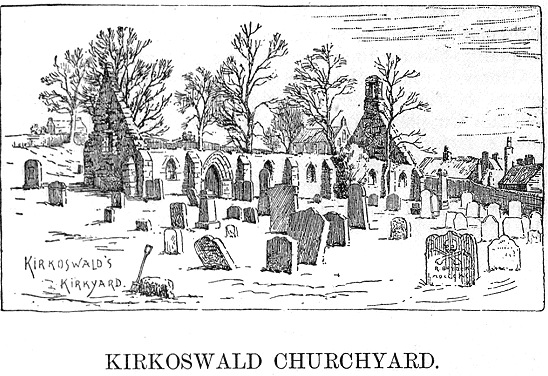|
Kirkoswald Churchyard is not so picturesque as Kirkmichael churchyard, but has its own share of quiet beauty too. The church itself is very old, having served the parish for ages; but in 1777 a new church was built on higher ground. It was in this church (August, 1562) old Abbot Kennedy preached those sermons against the Reformation which brought John Knox down upon him, and led to the famous Debate at Maybole. And it was in this church, too, Robert Burns worshipped under the Rev. Matthew Biggar, while attending Hugh Rodger's school, in the summer of 1776. Some years afterwards, the first Marquess of Ailsa built a Tomb in the old ruins for himself and his family, but it has never been used. There are three tombstones here connected with Burns, and all standing close together. The first is the one to the extreme left in the engraving, which is the family memorial of the Browns, from whom Burns' mother came. This stone was rapidly mouldering away when the late Dr Charles Rogers of Edinburgh, in 1883, raised a sum of money to preserve it, which has been done suitably. The tombstone standing next to the Browns' is that of Douglas Graham of Shanter (the immortal Tam), with some highly evangelical lines written on the back of it. And the next in order is that of Hugh Rodger, who taught Burns what little mathematics he knew, and which came in opportunely to qualify him for the post of gauger at Dumfries. Grouped round the east end of the church are the graves of the former ministers of the parish, including William Cupples, who edited John Stevenson the Covenanter's memoir, with several members of the family of Wodrow the Church historian, who died here. Against the west wall of the churchyard, but not seen in the engraving, are two curious rhyming epitaphs, which run to the following effect MARURAT
PROVAN. MARY
BEKWITH. The epitaph recording the names of Burns' mother's relations runs thus: "Here lyes the corps of John Brown in Littletown, who died March 3, 1724, aged 50 (the grandfather), and Janet M'Grean, his spouse, who died March 28, 1738, aged 60; and Agnes Renie, who died May, 1742, aged 34 (the mother), and Margaret Blair, who died June, 1751, aged 36, spouses to Gilbert Brown in Craigenton, and Agnes Stivn, who died 1748; also James Brown in Riddlestown, who died June 29, 1780, aged 65 years." On the top, but now concealed by the new stone "Gilbert
Brown, died 31 Oct., 1774, aged 66" (the father). On the back, "Erected by John and Gilbert Browns and
Robert, and John, and Samuel, and William, and John From this somewhat confused account, we gather that the poet's mother's father was thrice married. She was the eldest child by the first wife, Agnes Renie. A touching remark of hers on her death-bed is recorded: "Are you not sorry to leave your husband and children ?" "No; I leave my children to the care of God, and Gilbert will soon get another wife "-which he did, two of them. Agnes Brown had little education, and never could sign her own name, but she was a good, kindly woman, a notable willing worker, and above all, she was the mother of Burns. All honour to her, and the parish that produced her! |
|
|
